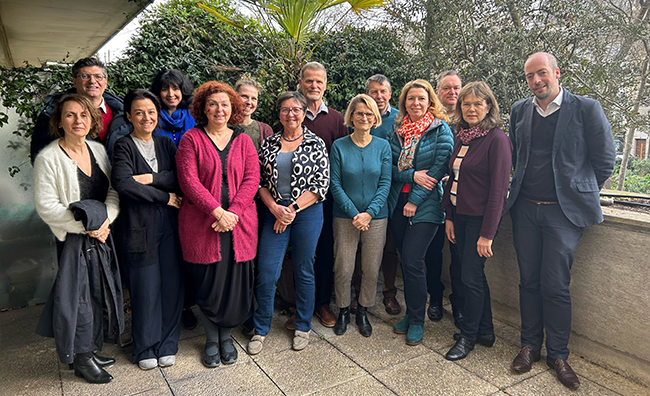
69th Meeting of the Panel on Phytosanitary Measures
EPPO Headquarters, 2023-03-14/16
The Panel met in Paris in the EPPO headquarters on 2023-03-14/16. The main task of this Panel is to evaluate risks presented by specific pests and design phytosanitary measures to avoid their introduction and spread.

Panel members
EPPO Lists of pests recommended for regulation
The Panel reviewed in detail EPPO pest risk analyses (PRAs) prepared by Expert Working Groups (EWGs) and PRA reports based on national/EU PRAs, to consider if these pests should be recommended for regulation:
- Tetranychus mexicanus (Acarida: Tetranychidae) - draft EPPO PRA: The Panel recommended to the Working Party the addition of this pest to the EPPO A1 List.
- Meloidogyne ethiopica and M. luci - PRA report based on a Slovenian PRA : The Panel recommended to the Working Party the addition of these pests respectively to the EPPO A1 and A2 List.
- Meloidogyne graminicola - PRA report based on an Italian PRA: The Panel recommended to the Working Party the addition of this pest to the EPPO A2 List.
- Crisicoccus pini (Hemiptera: Pseudococcidae) - PRA report based on an Italian PRA, an EFSA pest categorization, a DEFRA PRA for the United Kingdom and a Swedish risk assessment : The Panel recommended to the Working Party the addition of this pest to the EPPO A2 List.
Following recent changes in taxonomy, Thekopsora minima will be listed as Pucciniastrum minimum in the EPPO A2 List.
Recent information received on the situation for Bactrocera dorsalis, ‘Candidatus Phytoplasma phoenicium’, Ripersiella hibisci, Scirtothrips aurantii and S. citri was shared with the Panel: Because official control on S. citri in Israel is not aiming at eradication, it was suggested that this pest is moved from the EPPO A1 to the A2 List. The other pests are maintained on the EPPO A1 List.
Alert List
The Panel reviewed the EPPO Alert List (the purpose of this List is to warn countries about possible new risks, and in certain cases to propose candidates for PRA and, if relevant, recommend them for regulation). No pests were recommended for deletion this year.
Pest Risk Analysis
A list of criteria for setting priorities for pests to be evaluated by PRA was reviewed by the Panel, and further guidance was developed. The new list includes geographical distribution, importance of the host(s) concerned, potential pathways, rapidity of natural spread, economic impact, availability and validity of data. The selection of priorities for the organization of EWGs for PRA for the year to come was performed using this guidance. The three highest priorities for PRA identified by the Panel were Chloridea virescens (Lepidoptera: Noctuidae – Tobacco budworm), citrus yellow vein clearing virus and Ceratocystis ficicola. The DEFRA PRA for beech leaf disease (under preparation in the context of EPPO Jens-Georg Unger Plant Health Fellowship), the EFSA pest categorisation and quantitative PRA for Resseliella citrifrugis, the EFSA pest categorisation for Toumeyella parvicornis, Oligonychus mangiferus and possibly for Phenacoccus solenopsis were identified for further review. The priorities for an EPPO PRA or a PRA review will be discussed by the Working Party.
Because of taxonomic issues for Phyllachora maydis, the Panel was in favour of pausing the drafting of the PRA and investigating maize-related pathways for this pest.
Since no reference is made to scientific publications about the efficacy of chemical pressure impregnation in the EPPO PRA for Megaplatypus mutatus, the Panel suggested to delete this from the recommended risk management measures.
A revision of the guidance document on PM 5/5 Decision-support scheme for an express Pest Risk Analysis was presented to the Panel. Practical experience gained when preparing PRA reports for particular Meloidogyne species was used to revise the Guidance for expert working groups for PRA and Panels on risk management measures for Meloidogyne species.
Information projects
The Panel was given a presentation on the recently developed platform on communication material, ongoing developments on Global Database (GD) consisting of adding lists of vectors for regulated plant pathogens and making links with other EPPO databases, and an update on the project which is in the process of updating datasheets for all EPPO A1/A2 pests.
The next Panel meeting is planned for 2023-10.
